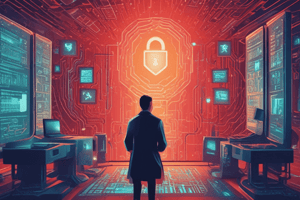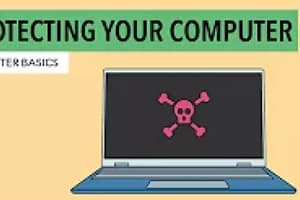Podcast
Questions and Answers
What is the primary function of input devices in a modern computer?
What is the primary function of input devices in a modern computer?
- To insert raw data in various formats for processing. (correct)
- To process data and generate outputs.
- To store data for future use.
- To display meaningful information to the user.
Which technological advancement primarily defines computers of the fourth generation?
Which technological advancement primarily defines computers of the fourth generation?
- Very large-scale integration (VLSI) microprocessors (correct)
- Transistor technology
- Integrated circuits (ICs)
- Vacuum tubes
Which of the following is NOT a typical component of a modern computer network?
Which of the following is NOT a typical component of a modern computer network?
- Routers
- Switches
- Vacuum Tubes (correct)
- Firewalls
What distinguishes fifth-generation computers from their predecessors?
What distinguishes fifth-generation computers from their predecessors?
Which of the following best describes the role of the CPU in a computer system?
Which of the following best describes the role of the CPU in a computer system?
In the context of future machines, what primary benefit is expected from quantum computing?
In the context of future machines, what primary benefit is expected from quantum computing?
What is the main characteristic of parallel processing in computer architecture?
What is the main characteristic of parallel processing in computer architecture?
Among the major network protocols, which layer of the OSI model does the IP (Internet Protocol) operate?
Among the major network protocols, which layer of the OSI model does the IP (Internet Protocol) operate?
What is the fundamental role of 'network topology' in computer networks?
What is the fundamental role of 'network topology' in computer networks?
What distinguishes the Internet from other types of networks?
What distinguishes the Internet from other types of networks?
Flashcards
What is a computer?
What is a computer?
An electronic device that takes raw data through input components, processes it, and turns it into meaningful information for efficient use.
Hardware vs. Software
Hardware vs. Software
Hardware components are the physical parts of a computer, while software components are the programs and instructions that tell the hardware what to do.
What are Input devices?
What are Input devices?
Input Devices are components that insert raw data to the computer in different formats for processing
What are output devices?
What are output devices?
Signup and view all the flashcards
Fifth Generation Computers
Fifth Generation Computers
Signup and view all the flashcards
What is the CPU?
What is the CPU?
Signup and view all the flashcards
What are storage components?
What are storage components?
Signup and view all the flashcards
What is a computer network?
What is a computer network?
Signup and view all the flashcards
Network Topology
Network Topology
Signup and view all the flashcards
What is the Internet?
What is the Internet?
Signup and view all the flashcards
Study Notes
- Introduction to Cybersecurity is covered in Lecture 1 of the Computer Science Dept., Faculty of Computers & Information.
Course Contents
- The course covers a range of topics from computer basics to cybersecurity risk management.
- Overview includes introduction to computers, cybersecurity and cryptography basics, cyberattacks, malware, and network security.
- It also includes countermeasures for cyberattacks, E-Commerce Security & Cybersecurity standards, plus revision and exams.
Lecture Outline
- Lecture will be about the introduction of computers, the history of computers, components of modern computers, future machines, computer networks, and the internet.
Introduction to Computers
- A computer is an electronic device processing raw data through input components into meaningful information for efficient use.
- A modern computer system is composed of hardware and software components.
Software Components
- This includes the firmware, operating system (OS), device drivers, and application software.
Hardware Components
- This includes the Central Processing Unit (CPU), data storage, input devices, and output devices, which are often called I/O devices.
History of Computers
- Computers have evolved through five generations, each marked by significant technological advancements.
- First Generation (1940-1956): Computers used vacuum tubes and ENIAC was a machine produced during this era.
- Second Generation (1956-1964): Transistor technology was implemented and UNIVAC 1 was the first commercial computer.
- Third Generation (1964-1971): Integrated circuits (ICs) formed the base.
- Fourth Generation (1971-2010): Very large-scale integration (VLSI) microprocessors are used in PCs, laptops and PDAs.
- Fourth Generation (1971-2010): Windows, Linux, UNIX, and Macintosh operating systems were introduced.
- Fifth Generation (2010-Present): Machines are powered by artificial intelligence (AI) and ultra-large-scale integration (ULSI).
Components of Modern Computer
Input Devices
- These are Keyboard, Barcode reader, Electronic pen, Wireless antenna and Scanner.
- Also Microphone, Camera, Joystick and USB port
Output Devices
- These include monitors, printers, speakers, headphones, projectors, and plotters.
Central Processing Unit (CPU)
- The CPU is the computer's 'brain', controlling its functionalities to generate, display, or save meaningful information.
- Key components of the CPU are the Arithmetic Logic Unit (ALU), Random Access Memory (RAM), Read-Only Memory (ROM), and Control Unit (CU).
Storage Components
- Data storage components save data in a secondary location for easy access and management.
- Storage components include Hard Disk Drive (HDD), Flash Disk Drive (FDD), Optical Disk Drive (ODD), and magnetic tapes.
Software Components
- Hardware components rely on software to function.
- Key software components are OS software, component drivers, application software, utility software, and firmware.
Future Machines
Artificial Intelligence (AI)
- AI is expected to make future computers smarter through augmented/virtual reality (AR/VR), voice recognition, text interpretation, image processing, and motion detection.
Quantum Computing
- Quantum computing can improve secure information sharing, enhance radar capabilities for aircraft detection, and aid in environmental monitoring using chemical sensors.
Nanotechnology
- This will lead to an exponential decrease in the size of hardware, especially in electronics and computer technology.
Parallel Processing
- This involves distributing computer processing across multiple components to increase processing power.
- Examples of parallel processing are virtualization, cloud computing, and distributed processing systems.
Computer Networks
- A computer network is a system of two or more computers connected to share resources, communicate, and exchange data electronically using rules and protocols.
- Networks consist of networking devices, computer hosts, wired/wireless media, connectors, and software protocols.
- Multiple computers are connected through physical and logical configurations and are known as network topologies.
Network Topologies
- Network topology refers to the way computers or devices are interconnected to form a network, and the topologies are physical references of network connectivity.
- Common topologies include star, bus, ring, mesh, and tree topologies, and combinations of these.
Major Network Protocols
- Ethernet is used for physical and data link OSI layer.
- TCP/SPX (Transmission Control Protocol/Sequenced Packet Exchange) is used at the network OSI layer.
- IP (Internet Protocol) is used at the transport OSI layer.
- HTTP/FTP (Hypertext Transfer Protocol/File Transfer Protocol) is used at the upper OSI layers.
- DNS (Domain Name System) and SMTP (Simple Mail Transfer Protocol) also operate at the upper OSI layers.
Components of Computer Networks
- Networks consist of hosts, routers, switches, hubs, firewalls, servers, cables/links, and protocols.
Types of Networks
- Networks are classified by coverage area as wired, wireless, or a combination.
- The types of networks are local area network (LAN), metropolitan area network (MAN), and wide area network (WAN).
What is Internet ?
- The Internet connects networks globally.
- It uses IP addresses to identify nodes.
- The TCP/IP protocol suite enables data transmission across the network.
Internet Services
- The major services include voice/video calls, chats, fax, email, social media, instant messaging, financial services, bill payments, online shopping and TV streaming.
- The services also include live movies, gaming, file sharing, data transfer, e-banking, data storage, e-marketing, remote healthcare, remote working and e-learning.
Studying That Suits You
Use AI to generate personalized quizzes and flashcards to suit your learning preferences.



